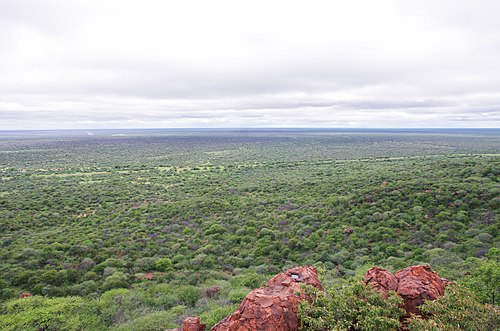
Woody plant encroachment (also called woody encroachment, bush encroachment, shrub encroachment, shrubification, woody plant proliferation, or bush thickening) is a natural phenomenon characterised by the area expansion and density increase of woody plants, bushes and shrubs, at the expense of the herbaceous layer, grasses and forbs. It refers to the expansion of native plants and not the spread of alien invasive species.[1] Woody encroachment is observed across different ecosystems and with different characteristics and intensities globally. It predominantly occurs in grasslands, savannas and woodlands and can cause regime shifts from open grasslands and savannas to closed woodlands.[2]
Causes include land-use intensification, such as overgrazing, as well as the suppression of wildfires and the reduction in numbers of wild herbivores. Elevated atmospheric CO2 and global warming are found to be accelerating factors. To the contrary, land abandonment can equally lead to woody encroachment.[3]
The impact of woody plant encroachment is highly context specific. It can have severe negative impact on key ecosystem services, especially biodiversity, animal habitat, land productivity and groundwater recharge. Across rangelands, woody encroachment has led to significant declines in productivity, threatening the livelihoods of affected land users. Woody encroachment is often interpreted as a symptom of land degradation due to its negative impacts on key ecosystem services, but is also argued to be a form of natural succession.[4] Various countries actively counter woody encroachment, through adapted grassland management practices, controlled fire and mechanical bush thinning.[5] Such control measures can lead to trade-offs between climate change mitigation, biodiversity, combatting diversification and strengthening rural incomes.[4]
In some cases, areas affected by woody encroachment are classified as carbon sinks and form part of national greenhouse gas inventories. The carbon sequestration effects of woody plant encroachment are however highly context specific and still insufficiently researched. Depending on rainfall, temperature and soil type, among other factors, woody plant encroachment may either increase or decrease the carbon sequestration potential of a given ecosystem. In its Sixth Assessment Report of 2022, the Intergovernmental Panel on Climate Change (IPCC) states that woody encroachment may lead to slight increases in carbon, but at the same time mask underlying land degradation processes, especially in drylands.[6] The UNCCD has identified woody encroachment as a key contributor to rangeland loss globally.[7]
- ^ Archer, Steven R.; Andersen, Erik M.; Predick, Katharine I.; Schwinning, Susanne; Steidl, Robert J.; Woods, Steven R. (2017). "Woody Plant Encroachment: Causes and Consequences". Rangeland Systems. Springer Series on Environmental Management. pp. 25–84. doi:10.1007/978-3-319-46709-2_2. ISBN 978-3-319-46707-8.
- ^ Cite error: The named reference
:53was invoked but never defined (see the help page). - ^ Shipley, J.R.; Frei, E.R.; Bergamini, A.; Boch, S.; Schulz, T.; Ginzler, C.; Barandun, M.; Bebi, P.; Bollman, K.; Bolliger, J.; Graham, C.H.; Krumm, F.; Pichon, N.; Delpouve, N.; Rigling, A.; Rixen, C. (19 August 2024). "Agricultural practices and biodiversity: Conservation policies for natural grasslands in Europe". Current Biology. 34 (16): R753–R761. doi:10.1016/j.cub.2024.06.062. PMID 39163831.
- ^ a b Ding, Jingyi; Eldridge, David J. (3 July 2024). "Woody encroachment: social–ecological impacts and sustainable management". Biological Reviews. 99 (6): 1909–1926. doi:10.1111/brv.13104. ISSN 1464-7931. PMID 38961449.
- ^ Eldridge, David J.; Bowker, Matthew A.; Maestre, Fernando T.; Roger, Erin; Reynolds, James F.; Whitford, Walter G. (2011). "Impacts of shrub encroachment on ecosystem structure and functioning: towards a global synthesis". Ecology Letters. 14 (7): 709–722. Bibcode:2011EcolL..14..709E. doi:10.1111/j.1461-0248.2011.01630.x. PMC 3563963. PMID 21592276.
- ^ Cite error: The named reference
:32was invoked but never defined (see the help page). - ^ Cite error: The named reference
:68was invoked but never defined (see the help page).